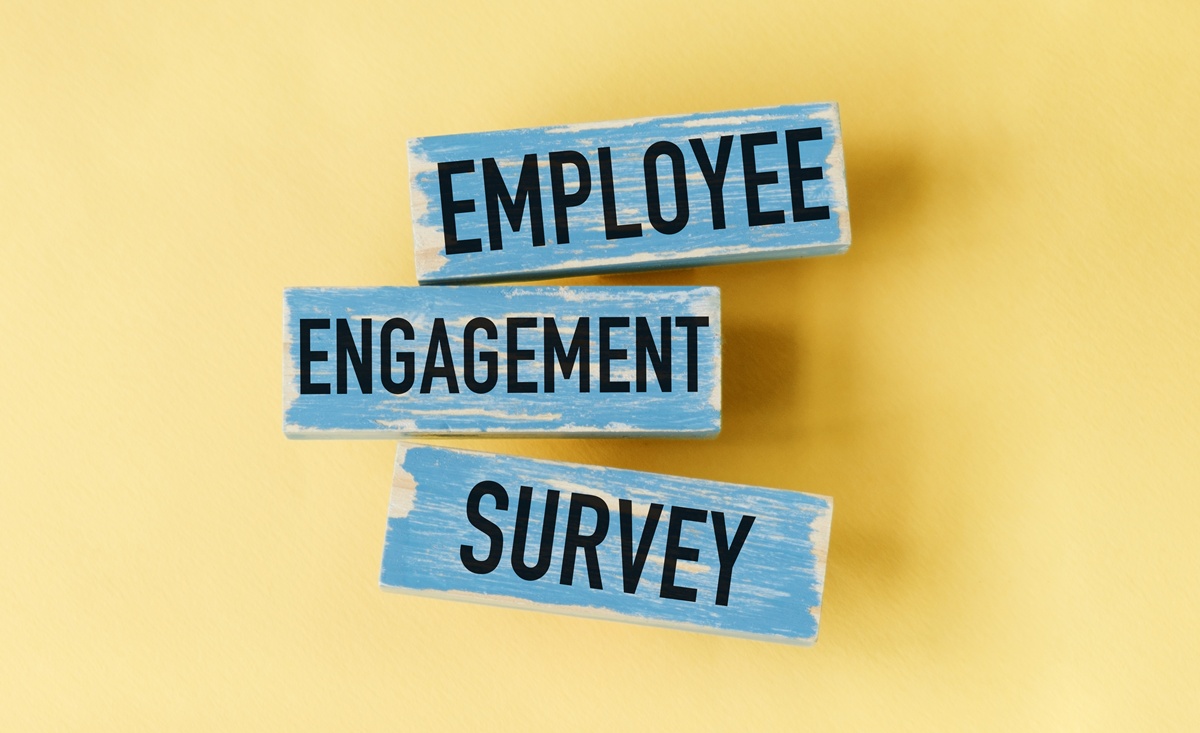October 01, 2025
Employee Engagement Survey Best Practices: Unlocking the Benefits of Feedback

Ask most leaders if they listen to their people, and they’ll say “of course.” But many employees don’t feel heard. That gap appears in subtle ways: lower energy, quiet exits, and the slow drain of “clock-botching,” where people do the minimum because they’ve stopped believing their input matters.
A thoughtful employee engagement survey can change that. It’s your chance to show your organization wants to know what helps people thrive, and that it’s willing to act.
There’s a strong business case for taking this seriously. Gallup links high employee engagement to 23% more profitability and 18% higher productivity. Yet disengagement still costs the global economy about $8.8 trillion.
Meanwhile, research shows that 87% of leaders believe a great employee experience attracts and retains talent, but only 51% believe their company actually delivers on that promise.
Surveys aren’t the whole answer. They work when they sit inside a larger listening system that includes open channels, well-timed employee experience survey moments (such as onboarding, promotion, or exit), and clear action items afterwards. But knowing how to optimize your surveys is a great place to start.
Employee Engagement vs Satisfaction and Experience
The terms: engagement, satisfaction, and employee experience, are often used interchangeably, but they’re not the same thing.
Engagement is that emotional pull people feel toward their work. It’s what makes someone jump in to help a teammate or fix a problem without being asked. It’s the “extra effort” people give when they care about their job and trust their manager.
Satisfaction’s different. It’s about being content with the role and workplace, including factors such as fair pay, decent benefits, good colleagues, growth opportunities, and a work-life balance. A team can be satisfied but coasting, or highly engaged but frustrated about pay, and quietly looking elsewhere.
Employee experience (EX) is the whole journey. It’s the mix of every touchpoint: onboarding, promotions, tools and tech, leadership style, and even the culture in meetings.
Why bother splitting hairs? Because it shapes the employee engagement survey questions you write and the actions you’ll take later. If you’re trying to prove return on investment, start with a clear view of how employee experience and engagement impact business outcomes. It’ll help keep your survey focused on what matters.
The Modern Employee Engagement Survey Landscape
There isn’t just one way to listen to your people. For a long time, companies relied on one-on-one interviews and lengthy questionnaires sent out annually. Now, many organizations are mixing several approaches to get a clearer picture and avoid survey fatigue.
Common survey types:
- Annual or biannual engagement surveys: Deep looks at culture, leadership, and motivation. Useful for trend data and benchmarking, but can feel cumbersome if the data is long or too frequent.
- Pulse surveys: Short five- to ten-question check-ins to take the temperature or test a new policy. Many run them quarterly, while others try monthly.
- Lifecycle surveys: Questions at key stages such as onboarding, promotion, return from leave, or exit. They reveal what it’s really like to join, grow, and leave your company.
- Culture and DEI surveys: Dig into belonging, inclusion, and whether company values feel real. Tools like Culture Amp make these sensitive topics easier to explore.
- Manager and leadership feedback (360 or upward): Managers shape most of the employee engagement story. Gallup’s Q12 model highlights that the direct manager relationship is one of the strongest engagement drivers.
- Transactional or IT service surveys: Short forms built into IT or HR systems. Zendesk shows how these “moment of truth” checks surface friction fast, before it becomes a bigger issue.
Beyond the Survey
Employee engagement survey questions reveal a lot, but there are other ways to gather data beyond asking staff questions directly. For instance, employee engagement software often includes anonymous comment boxes, chatbots, or AI that scans open-text feedback for themes. This kind of real-time listening is growing fast as AI moves “into the driver’s seat” of experience measurement.
Then there are behavioral insights and passive analytics. AI-powered tools can analyze collaboration data, turnover risk, or digital tool usage to predict trouble before people even fill out a form. Used carefully, it’s a way to stay ahead without adding more surveys.
Mixing surveys with data from analytical tools can provide deeper insights. For instance, Wahi, a Canadian real-estate platform, kept engagement high without a whole HR department by blending short pulse surveys with lifecycle check-ins. That mix gave leaders early warnings and time to act.
Setting Goals, Governance & Choosing Tools
Before you write a single employee engagement survey question, pause. Ask yourself what you really need to know. Good surveys don’t try to cover everything; they have a clear purpose
Skip vague aims like “improve culture.” Ask instead: Do we want to reduce turnover? Speed up onboarding? Catch burnout early? One or two sharp targets keep the survey focused and easier to measure. Then link answers to outcomes that matter, such as retention, productivity, and customer experience, so you know which numbers to track.
Quick Tips for Success.
Once you’ve set goals, build trust. People won’t be honest unless they feel safe. Be clear about privacy, keep reporting anonymous (especially in small groups), and explain how results will be used.
A few other ways to make sure you’re set up for success include:
- Test before a full launch: Run a short pilot with a small group to catch confusing wording or overly long sections. This simple step can improve clarity and keep response rates high.
- Choose technology that fits your needs: Modern employee engagement software can break down results by team or role and highlight trends with the aid of AI. Qualtrics, Culture Amp, BambooHR – choose the one that suits your size and budget.
- Decide who owns the process: Someone has to run the survey, report the results, and make sure action happens. Otherwise, nothing changes.
Laying this groundwork of purpose, trust, and the right employee engagement software sets the stage for everything else. It turns your survey from a simple questionnaire into a tool that sparks real change.
Choosing Employee Engagement Survey Questions
With goals in place and employee engagement software ready, focus on the questions. Good design = valuable insight. Drop jargon and double-barrelled items (“How happy are you with your pay and your manager?”). Use plain words that everyone gets. Mix formats: 5-point scales for trends, 0–10 ratings for things like eNPS, and a few open boxes for context. Keep it brief, too; long surveys tank response rates. Sharesies kept theirs short and got 95% participation.
Your questions should flow from your goals, but most strong employee engagement surveys touch on:
- Purpose and connection: “How does your work contribute to the company’s goals?” or “Do you feel fulfilled by your work?”
- Career growth: “How much do you think you’ve grown since you started here?” or “What skills would you like to develop with training?”
- Manager relationship: “How confident do you feel asking your manager questions?” or “How often are you given useful feedback?”
- Wellbeing and Burnout: “How often do you feel stressed at work?” or “What would make you feel more comfortable in your role?”
- Belonging, DEI, and culture: “How would you describe the company culture at [Brand]?” or “Do you feel well represented at [Company]?”
- Enablement and tools: “Which tools do you use most often in your role?” or “What kind of tools would make your workflow easier?”
The Employee Engagement Survey: Driving Participation
The toughest part of any employee engagement survey isn’t writing the questions. It’s getting people to answer honestly. The best way to address that issue is with transparency.
Tell employees what the survey is for and how you’ll use it. Skip the corporate slogans. A simple note works: “We want to know what helps you do great work and what’s getting in the way.”
Make sure to address privacy upfront as well. People only speak freely if they feel safe. Clearly state who has access to the data and how it’s organized. For example: “Managers will only see combined results from teams of five or more.”
Other good ways to boost participation include:
- Pick your moment carefully: Don’t send a survey just before holidays or right after layoffs. Think about shift patterns and remote schedules so people can answer.
- Make it easy: Make it short enough for one sitting, skip options when questions don’t apply, and make it mobile-friendly for those on the go.
- Remind gently: One or two friendly reminders are enough. A quick note from a manager works better than a system email blast.
- Show gratitude: A gift card can nudge numbers, but public thanks and visible action make a difference too. Employees want to know their effort counts.
Unifonic boosted its response rate by clearly explaining how anonymity worked and showing how leaders planned to use the feedback. People took part because they trusted it would lead to real change.
Employee Engagement Surveys: Analyzing & Interpreting Results
Collecting answers is just the start. The value of an employee engagement survey comes from what happens next.
- Start with response patterns: Look at overall participation first. If some teams barely replied, that’s a signal in itself, possibly low trust or survey fatigue. Low or uneven response rates can mean fatigue or distrust.
- Segment, don’t just average: A single company-wide score can hide big differences. Break results down by team, role, tenure, or location. Tools like SurveyMonkey and Qualtrics make this simple. Low scores in one area often point to a clear issue like workload, growth, or manager support.
- Look for drivers, not just scores: It’s tempting to focus on “overall engagement,” but you need to know what shapes it. Tools such as Qualtrics run driver analysis: they look at how each survey item correlates with engagement. Maybe recognition, not pay, is the strongest predictor for your people this year.
- Use text analytics wisely: Open-ended comments can feel overwhelming. Modern employee engagement software uses AI to spot recurring themes and sentiment. Pair this with human review to understand the nuances behind the numbers.
- Follow up with conversation: Numbers tell you where to look; people tell you why. Use mini-pulse surveys or small focus groups to dig deeper into unclear findings. Zendesk suggests this as a way to avoid overreacting to a single data point.
Path offers a good example. The team used Culture Amp to spot cultural gaps that were pulling people away from the company’s mission. Leaders acted on what they found, gave staff clearer direction, and saw engagement rise where it mattered most.
Closing the Feedback Loop
Collecting answers is easy. Acting on them is harder and more critical. If nothing changes, trust drops, and future response rates sink.
- Share what you found: Give employees an honest summary of wins and weak spots.
- Act at all levels: Some fixes need executives; others, like recognition habits, are manager-level. Good employee engagement software helps managers turn results into plans.
- Balance quick wins with bigger fixes: Small, visible improvements build trust while longer-term issues are tackled.
- Support managers: Give them guides for talking through results.
- Re-check progress: Use pulse surveys or informal follow-ups.
- Use tech smartly: AI can flag early trouble, but action must stay human.
Closing the loop doesn’t require perfection, just visible progress. When employees know their answers lead to action, your next employee engagement survey won’t feel like a checklist item.
The Benefits of Employee Engagement Surveys
When it’s used well, an employee engagement survey is far more than a morale check. It drives measurable business results if you act on what you learn. Companies end up with:
Better retention:
Turnover is expensive, and exit interviews usually come too late. By asking the right survey questions, you can spot warning signs early. OLX Group used Culture Amp to rewrite and focus its survey questions during a period of change. The clearer data highlighted drivers of voluntary turnover, helping leaders act and cut attrition.
Higher productivity and innovation:
Engaged employees put in discretionary effort and offer ideas to improve how work gets done. For instance, Stingray shifted to a “people-powered decisions” model after analyzing engagement results, improving output, and team problem-solving.
A stronger culture and sense of empowerment:
Surveys, when paired with action, show employees their voices matter. Dennemeyer used SurveyMonkey Enterprise to build an employee-centric culture. Leaders didn’t just collect feedback; they shared results and followed up, which boosted trust and long-term engagement.
Better customer experience:
Employees who feel heard tend to create better experiences for customers. For example, Zoetis used Qualtrics EX tools to understand employee pain points, then addressed them. Customer service scores rose alongside engagement.
Employer brand and talent attraction:
A visible feedback culture helps recruit and retain talent. Tonkin+Taylor strengthened its reputation as a caring employer by acting on survey findings and communicating progress to staff, boosting talent attraction.
A well-run employee engagement survey isn’t just an HR exercise. It’s a signal that leadership wants to listen, and a tool to keep people engaged, productive, and delivering better results for customers.
Employee Engagement Survey Challenges
Running an employee engagement survey may sound simple: ask, gather, and act. But a few traps can sink it.
- Survey fatigue: Long or frequent surveys make people skim or ignore them. Keep pulses short and spread topics across the year instead of one giant form.
- Asking but not acting: Nothing damages trust faster than silence after a survey. If employees don’t see movement, response rates will nosedive next time. Even small updates, “You said this, here’s what we’re working on”, help keep credibility intact.
- Privacy gaps in small teams: If a manager can guess who said what, honesty disappears. Use safe reporting thresholds (for example, no results for groups under five people) and be upfront about how anonymity works.
- Buying tech without readiness: Fancy employee engagement software with AI dashboards won’t fix a lack of process or leadership buy-in. Before investing, think about whether you’re ready to use advanced features.
- Drowning in data: Collecting more feedback than you can use frustrates everyone. Employees stop believing change will happen; HR drowns in spreadsheets. Keep insights tied to clear business goals.
Most failures come from lost trust or no follow-through. A strong employee engagement survey program protects anonymity, stays focused, and always acts on what it learns.
Turning Feedback Into Lasting Change
A solid employee engagement survey is more than a form. It’s a way to listen, act, and prove that employee voices shape the workplace.
The process begins with clarity: determine whether you’re measuring engagement, satisfaction, or the entire employee experience. Pick the right survey style and set clear goals. Protect privacy, keep questions clear, and choose employee engagement software that makes results easy to understand and share.
Most importantly, close the loop: tell people what you found and what’s changing. Companies that do this keep talent longer, spot burnout sooner, and often improve the customer experience as well.



